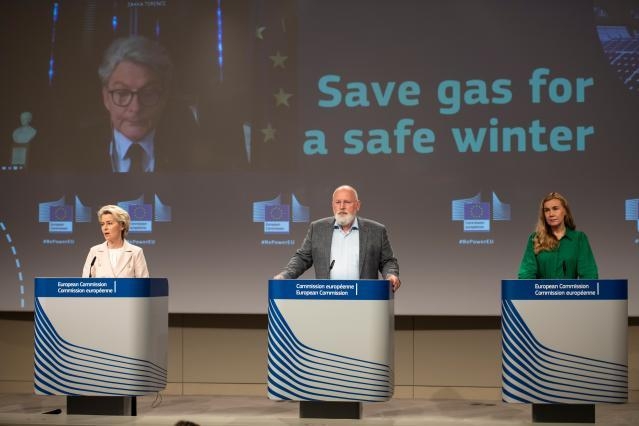The European Commission proposed on Wednesday plans for reducing the demand for natural gas in the EU in response to a worst possible scenario when Russia will cut off natural gas to EU member states.
Since the start of Russia’s unprovoked invasion of Ukraine on 24 February, the EU has imposed successively packages of sanctions against Kremlin. Germany suspended certification of the second Nord Stream pipeline (Nord Stream 2) but still counts on that the first one (Nord Stream 1) to become operational after maintenance work.
Sanctions against Russia’s exports of natural gas have also been discussed but never really been in the pipeline because of EU’s dependence on natural gas and the objections by some member states. Chief Commission spokesperson Eric Mamer told the Brussels Times that the Commission will not speculate on possible future sanctions packages and what they could contain.
However, with its saving plan, the Commission anticipates that Russia will use the gas as a weapon against the EU. The option of EU sanctions against import of natural gas from Russia seems therefore definitely off the table and not relevant any longer. As previously reported, a leak from the proposal showed the EU is not ready for a sudden end to Russian gas imports.
At a press conference on Wednesday, European Commission President Ursula von der Leyen explained that Russia is blackmailing the EU and that 12 EU member states are already hit partially or totally by disruptions in the supply of Russian natural gas. They have all triggered early warnings or alerts about their energy situation.
Supply to the Baltic States, to Poland, to Bulgaria, to Finland has stopped. Supply to several countries, including Poland, Germany, Austria, Denmark, Slovakia, the Netherlands and Italy has been reduced. Since mid-June 2022, flows through Nord Stream 1, have been cut by 60%.
Von der Leyen was referring to a Communication, ‘Save gas for a safe winter’. “In the event of further disruptions of supply, or a full cut-off, Europe needs to be ready. In the spirit of European solidarity and cooperation, the EU needs to ensure that the gas flows where it is most needed, protecting both our domestic customers as well as our jobs and the economy as a whole.”
A full-cut off of Russian natural gas is a likely scenario, the Commission President underlined. When it happens, it will hit all the EU. “Our worst enemy is fragmentation,” she said, pleading for European solidarity. “We need to act in solidarity.”
Vice-President Frans Timmermans was even more outspoken at the press conference. “Part of President Putin’s efforts is to weaken and divide us. It is difficult to predict what will happen but we have to be prepared for the worst scenario.”
“Shortfalls in supply will affect every member state because of their serious impact on the EU economy as a whole. We cannot allow the situation to spiral out of control.”
He assured that households, together with essential social services, are ‘protected customers’, but that they also can contribute to saving gas.
Frans Timmermans was referring to the Gas Security of Supply Regulation which includes a solidarity mechanism, which guarantees supply to ‘protected customers’ defined as households, district heating that cannot switch to other fuels and certain essential social services, such as healthcare.
It is up to each member state to decide how best to apply demand reduction but they are encouraged to launch information campaigns to raise awareness among citizens and take measures to reduce heating, for instance, in public buildings.
The main point in the Commission’s new legislative tool is to reduce gas consumption in Europe between 1 August 2022 and 31 March 2023 by at least 15% compared to their average consumption in the same period during the five preceding years. They should build on the measures and criteria set out in the European Gas Demand Reduction Plan. The full plan has been published as an annex to the Communication.
The Commission explained that the calculation is fair to all member states and easier for those member states that already have started reducing their gas consumption in previous years. In fact, some member states, as for example Finland and the Netherlands, have already started saving gas, Kadri Simson, Commissioner for energy, said.
This goal is aspirational to start with but can become binding if the Commission declares a “Union alert” in case there is a substantial risk of a severe gas shortage or an exceptionally high gas demand. The gas storages in the EU are currently filled to close 65 % but the target is to fill them up to 80 % before the winter.
Key findings of the Commission’s scenario analysis show that without additional preparedness, under average weather conditions and continuously high LNG supply, the storage would run nearly empty at the end of March 2023, leaving therefore no buffer for the gas season 2023-2024.
Savings will not be enough. A crucial point is the plan is to replace natural gas by other fuels. Where possible, priority should be given to switching to renewables or cleaner, less carbon-intensive or polluting options. However, switching to coal, oil or nuclear may be necessary as a temporary measure, as long as it avoids long term carbon lock-in.
Another component is the REPowerEU plan which aims to end the EU's dependence on Russian fossil fuels as soon as possible by diversification of imports from other countries. It will take time but the plan is already working thanks to higher LNG and pipeline imports from other suppliers.
In the first half of 2022, non-Russian LNG imports rose by 21 billion cubic metres (bcm) as compared to the same period last year. The share of the US in the EU LNG imports was around 46% in June. Non-Russian pipeline imports also grew by 14 bcm from Norway, Azerbaijan, the United Kingdom and North Africa. Altogether, this offsets the reduction in Russian imports during the same period.
M. Apelblat
The Brussels Times

